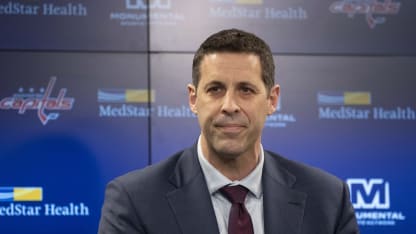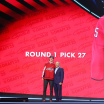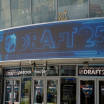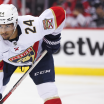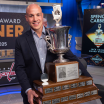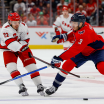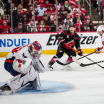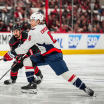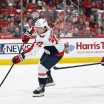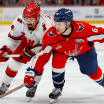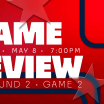Things have been going rather swimmingly for the Washington Capitals this season. With the NHL’s 2024-25 trade deadline now just over a week away, the Caps own a sparking 38-12-8 record as they head into the final two dozen games of the season. Team captain Alex Ovechkin is now a dozen games shy of surpassing Wayne Gretzky (894) for the top spot on the NHL’s all-time goals ledger, and Washington holds a 14-point lead over its closest competitors in the Metropolitan Division standings.
We had a chance to sit down with Capitals senior vice president and general manager Chris Patrick for a short conversation on the state of the team with the trade deadline looming, and here’s how it went.
First off, I’ve got to ask you about Ovi. You’ve been a fan of this team for a long time. What's this been like to see his progression, really since the start of last season, where he started out with I think was eight goals in 43 games, and now he's got 51 in less than 82 games since then.
“His whole career, every time you think there's nothing that can top this, he finds another way to top it. I remember the beginning of the year, I had some media availability, and somebody was asking me, ‘Do you think he can do it this year?’ And the math and the logic says no, but I mean, it's Ovi and he's always defying the odds and defying conventions. But it's just been incredible to watch and so much fun to watch and I’m really just on the edge of my seat here for the rest of the season.
“And typical of him, we're sitting here today, and he's got 12 goals to break it. And now there's finally some rumblings of like, ‘Let's talk about Alex more.’ Because up to this point, it's always been when people bring it up, like when we go to Canada they all want to talk about it. He's like, ‘No, no, no. Talk about the team. Let's talk about our game tonight. I don't want to talk about the goals.’ This whole time, he's just kept it on the team, it's about the team, ‘We're winning, we're trying to win a Stanley Cup, that's what I'm concerned about.’ Which is also just completely on par with his personality and approach to the game and to the sport. It's been really fun to watch, and I already obviously had tons of appreciation for what he's done for our team, our city and our league and this just brings so much more of that for me.”
He never wanted to score the goals and ride off into the sunset. He wanted to play for a competitive team this whole time, and hockey operations and ownership was in full agreement with that. But being in agreement with that and then actually making it happen, those are two vastly different things. How satisfying is it to see that in essentially two years, you guys in hockey ops have been able to engineer that?
“It's really satisfying. From a hockey ops perspective, anytime you know, you make deals for players or you sign players, you have a hope of how it'll work out and how it'll fit, but you still don't know it until you own it. And to have a lot of it work out the way we hoped – and in a lot of cases better than we hoped – has been really fun. And I always felt like with Alex, if, if getting this record was a goal that we had as an organization for him, the best way to do it is to have a good team. Because the better your team is, the more the other team has to worry about, not just Alex, but other players too. And really, everybody is elevated because of that. So hopefully, that's kind of what's happened here, and hopefully we can keep it going for the foreseeable future.”
How are contract extension discussions going with the pending UFAs you’d like to have back for next season?
“We've talked with them, and I think we've made progress. The League giving the salary cap guidance was helpful to the process for and for us from a planning perspective. And I remain positive that we'll be able to get something done that makes sense. It'll take some time. And luckily, given where we are in the standings, there's no artificial deadline for us with the trade deadline. We can continue our talks up to and after the trade deadline; we're not going to be moving any of these guys prior to that so yeah, hopefully we can get something worked out for them.”
You mentioned that salary cap guidance. We're essentially five years removed from the onset of the pandemic that flattened the cap. How liberating does it feel for you guys? Because for the last half decade, things have been extremely tight in that regard. Now it just feels like the window, not just for you guys, but for all 32 teams, is open a bit wider, but the other side of that coin is the guys who are on the market this year may be poised to potentially hit the jackpot, too.
“I actually think it's going to be interesting. I think it's going to introduce maybe some things that we haven't had to think about in a while. It feels like, for the most part – unless a team was going through a rebuild – everybody has kind of been cap teams, or pretty close to the cap, with few exceptions. And now we get back to how it was when the salary cap first came around, where you have some teams that are cap teams and some teams that are we have a budget, and that's their cap, which is lower than the cap maximum. You can see that being a scenario, especially when you look at some of the two- and three-year out guidance they gave us.
“And I also wonder, does it change how a player approaches free agency? If you have a guy that's going to be an unrestricted free agent, they know now with pretty good certainty what at least the low end of the cap will be for the next three years. Where it goes from there, could it be a lot higher, potentially? Maybe players, instead of saying, ‘I want seven years, I want eight years,’ maybe they're looking for a shorter term deal for these next three years, and then they'll have another deal after that, where maybe the cap is higher and they can cash in on that change. I'm curious to see the ripple effects through the business side of it, and how it might change approaches, both on the team side and the and the player side.”
Do you guys have to guard against, not necessarily overvaluing, but maybe overpaying, because of the tendency to think, ‘Well, the cap is going to keep on climbing?’
“Guidance is guidance, but it doesn’t account for the unaccountable. And you just have to look back to COVID; nobody ever saw that coming. You can give credit for where the cap is going in the next couple years, but you do have to be careful against giving credit for stuff past that, I think. And that's part of our job, is make sure we try to protect ourselves against those kinds of uncertainties. That’s how we approach it.”
You've been around for a lot of these deadlines over the last 15 to 20 years. But how drastically different does this one feel from certainly the last two?
“Obviously the last two, we were definitely fully in a sale mode. And last year we were kind of, ‘Let's sell a little bit and figure out how much we want to sell,’ And I'm glad we didn't cut too far down to the bone, because I think it kept us set up for our success this year. It definitely feels like there are maybe fewer defined sellers out there right now than maybe in years past, because there's so many teams right in the mix. There are so many teams that are like, ‘Hey, we've been a seller for two or three years. Even if we're not going to make it, I want to hold what I’ve got, because we need to at least make it a run at it here.’
“So it feels like there are not as many names circulating out there on the market as potential rental type guys. And from our team's perspective, it reminds me a lot of the 2010 year, the year we played Montreal [in the playoffs]. That team – from wire to wire – was a really good team. And you can make an argument that you really don't need to be too drastic with adds and there's a risk of over-tinkering. And I feel like that's kind of where we are right now. You want to walk that line between showing the guys, ‘Hey, we see what you've done, and you guys deserve for us to do whatever we can to improve the team.’ But we also don't want to throw a wrench in the whole system, or throw off the vibe, or how things have been going by doing too much.”
What's your assessment of the depth at hand in the cupboard? Even if you are thrilled with the way everything's going, the idea is to keep playing until late June. And as well as everything's gone so far, health wise, there's always the possibility of attrition when you've got, ideally, 50 games still to be played here. What do you think about what's in the cupboard right now, including guys who are scratched nightly, and what you've got down in Hershey?
“I think that would be an area where we'll look at things here at the deadline, if there's an add we can make to help with our depth. The question marks right now, we've got Sonny [Milano], who's been out for most of the year, and he has been working hard on his return to play, but still isn't quite there yet. So we'll have to see where he is. If he's getting close come playoff time, maybe he's a guy that comes in and is almost like an official trade deadline add.
“We'll take another run at Ryan Leonard here once his season is done, just like we did last year. Maybe this is the year that we can convince him to come out, and that would also be another player that will be coming in, and it gives you a guy as far as death. And we’ve got Hendrix [Lapierre] and [Ivan Miroshnichenko] down in Hershey that obviously have NHL experience with us. I think Mike Sgarbossa can give you solid minutes as a call-up if you need them. And then on the back end, we're at eight up here, plus you’ve got [Vincent] Iorio, [Ethan] Bear and [Chase] Priskie down in Hershey, so that gives you 11. But again, it's always good to have – I think – 10 to 12 [defensemen] that can play for you. So maybe that's another area that we look to add.”
I know that the day of the trade deadline that the 23-man roster limit goes away, and you can plug in however many people you can fit under the [salary] cap. And for the first time in a long time, you’ve got a little more than a nickel under the cap to work with. I know you’ve got to keep space for Leonard, and for his bonuses, too. Are you envisioning any scenario where on March 8, you could have – even without Leonard – you might have 24 or 25 guys? Or is that not possible?
“I think it’s possible. [Assistant general manager and director of legal affairs] Don [Fishman] does a good job of finding ways to squeeze guys in, so I wouldn't put anything by him at this point. Yeah, it would definitely be possible. It might just result in – if Leonard does come – some transactions after that to make us cap compliant. But if he comes, hopefully that's after April 12, which would be the finals of the NCAA tournament. So it would only be for a couple of days, but it'll be tight, as always. We'll be right up against it.”
The two-year anniversary of the [Dmitry] Orlov/[Garnet] Hathaway trade was a couple days ago, and the two-year anniversary of the [Rasmus] Sandin deal is Friday. For me, that's kind of the of demarcation, where things just really start to turn around. Obviously, the major bulk of the work was done last summer, but I feel like that was kind of the turn. What are your thoughts on, just the way everything has developed since then? And specifically to Sandin, what are your thoughts on how he has developed, because he just – a couple games ago – crossed that line where he's played more games as a Capital than he played with Toronto?
“As far as Rasmus’ development, I think he's done a really good job at understanding the need to have a complete game. He can't just be an offensive guy, puck moving guy, and he's worked really hard on the defensive side of the game and his detail there has gotten better, month-to-month, week-to-week, game-to-game, to the point where he's just become a really dependable, two-way defenseman. I think he defends and brings offense, and I think he has an impact at both ends of the rink.
“And again, when we talk about things working out as good or better than you hope, when we were talking about him at the time [of the trade] with Toronto, and we're talking about with our group internally about what he could become and what's our projection for him, I think the defensive side of his game developing the way it has is has definitely worked out better than we probably could have hoped. And I think it's been a big credit to him for putting the work in and being open-minded and not saying, ‘No, I'm an offensive guy, I need to play on the power play.’ He just goes out and plays his role and does a good job with it. He has been a really low maintenance, hard-working guy.
“And then as far as the overall strategy that kind of started with the Sandin trade, I think obviously [president of hockey operations Brian MacLellan] having the foresight and the comfort to say, ‘Hey, instead of just going out and getting the hottest 34-year-old free agent at the trade deadline and just trying to keep doing what we've been doing, our core is getting older, and if we don't do something to try to add youth to our group, we could be in a pretty bad spot.’
“Once you kind of get the go ahead, then it's like, ‘Hey, in everything we do, let's be trying to get a little bit younger.’ Then it’s just having that approach to how you're looking for and identifying players, and I think it starts to build from there. You start finding other guys that you like, and it’s ‘Hey, if this guy becomes available, we like him.’ Or a team floats a name out there and you’re like, ‘Yeah, this could be fitting in with what we're trying to do here.’ I guess it was able to give us the mindset to say, ‘Hey, it's okay, we may be trading out the bigger name right now, but if we're getting back a younger guy that we think would be big part of the future, we're okay with that.’”

